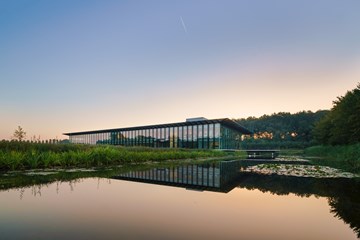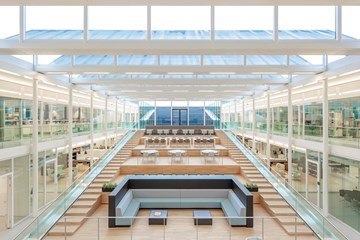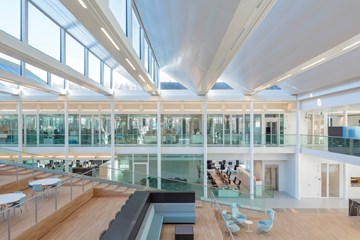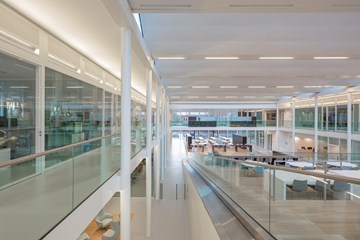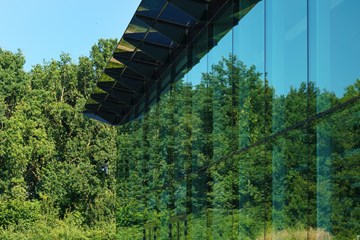KWR Watercycle Research Institute
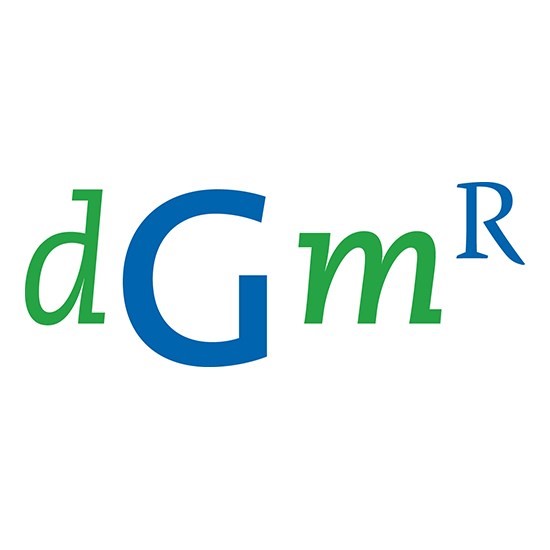
KWR Watercycle Research Institute is a renowned research institute in the field of water and water cycles, which develops expertise and makes it accessible to various national and international organizations such as drinking water companies, regional water boards, local governments and trade and industry. At the green business location on the Groningenhaven in Nieuwegein, a new office is currently replacing the existing building, which was out-dated and no longer met today’s requirements. cepezed’s design is strongly interwoven with and makes maximum use of the surrounding landscape. The building is elevated more than a metre above ground level, making it an open, light and transparent pavilion on a plateau. To create a pleasant space outside and effective protection from the sun, it has been provided with a broad canopy at the top. The pavilion itself is largely made of glass, which gives the users an optimal connection with the green surroundings. The building structure consists mainly of two generic bays 12 metres deep. These do not have any supporting walls and have a gross storey height of four metres. This arrangement allows for every conceivable combination of laboratories, offices and shared functions such as meeting spots, quiet spaces, brainstorming spaces, meeting rooms, project team areas and so on. The bays are interconnected by means of passages and footbridges. In between the bays, a stepped atrium represents the beating heart of the building; This is a place where people can come together, work and confer, but also drink coffee and eat in the restaurant. The restaurant underneath, on the south side of the building, can be closed off from the rest of the building and as a result is multifunctional and can, for instance, be used for conferences or other gatherings. The other functions are accessed separately and are therefore always easy to reach. The parking spaces are situated apart in the green area, so employees have a short walk through the landscape every morning to get to the building. The pavilion has a green roof that appears to run inside via the central stepped atrium, so that nature almost literally continues into the building. In addition, a series of integral sustainability measures were included in the design; these measures fit in well with KWR and are also in part focused on achieving optimal water management.
Project partners
Name
cepezedArchitecture, Developers, Designers, Interior architecture
Company Type
Architecture, Developers, Designers, Interior architectureArchitecture, Architectural engineering, Building design, Modelling (bim), Urban design
Design & Development
Architecture, Architectural engineering, Building design, Modelling (bim), Urban designName
DGMRConsultants, Engineering
Company Type
Consultants, EngineeringEnvironmental consulting, Acoustics, Building physics
Engineering & Safety
Environmental consultingComfort & Health
Acoustics, Building physicsName
DWAConsultants, Engineering
Company Type
Consultants, EngineeringBuilding services engineering (mep)
Comfort & Health
Building services engineering (mep)Related projects
No results found
Did your company worked on this project? Go to the Public page and list yourself as a project partner to access your company only page
Which project partner should receive your project listing request?
Document generator
Thank you for using the document generator again! Click the button to start a free trial period of 5 documents.
Document generator
Your trial period has been expired. Please contact info@galleo.co.
Click the +Favorite button to add this project to your personal favorites

